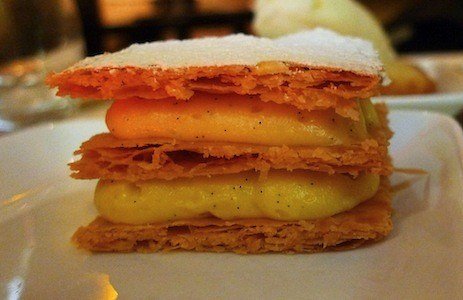Drouant

Fri 13 May 2022

Mille-feuille.
16–18, place Gaillon, in the 2nd Arrondissement.
Lunch and dinner daily.
01 42 65 15 16.
Drouant is a classic, but for some reason I had never gotten around to visiting. In a city with thousands of restaurants, I suppose this isn’t too hard to understand, but my own biases are also to blame. I love small, personal restaurants, and Drouant, with its sprawling set of dining rooms and almost equally as sprawling menu, never really called to me.
That’s a shame, because after eating there I can now think of plenty of occasions when this would have been a good choice or recommendation: for that family who wanted an elegant night out, for a friend and her parents who hate eating elbow-to-elbow with strangers or even (and this is the one that matters) for myself.
Walking into Drouant, I was glad to see the pretty façade and prettier terrace. The restaurant faces the lovely place Gaillon, and I’m sure the tables outside are packed during warmer months. Inside, a sort of understated luxury takes over; it’s not full of character, but it’s very comfortable, with low lighting, white linens and cushioned chairs and carpeting that absorb the babble of guests and the footsteps of servers.
Once you see the menu, it becomes clear that, though Drouant may be a classic, it is not old fashioned.
To wit: the starters come in sets of four, organized by theme: Les Legumes, Les Poissons, Les Classiques and Les 4 Coins du Monde. We chose the vegetables. The pumpkin soup was pure and intense. Cauliflower was turned into an ethereal cream and given crunch from a Parmesan wafer. A carrot and raisin salad took us out of Paris with no small amount of spice, and thinly sliced beets were assembled into a short stack of earthy sweetness. What I loved about this set of dishes was the way, in each case, humble ingredients were elevated to elegance.
Roast monkfish.
The main courses offer an encyclopedic variety of fish, fowl and meat. We had roast monkfish, served with a meaty jus, and a porcine duo of Spanish pluma (a tender piece from the end of the loin) and braised belly, one lean, the other lush. Vegetables were served in separate dishes for sharing, family style, including a de rigueur potato puree and an unusually delicious creamed spinach.
It was not easy to choose a wine from the heavy list; we were at first disheartened by the prices, not realizing that we were looking at the reserve section. Prices in the front of the book skew a bit high, too, but that’s to be expected at this kind of address. In any case, to straddle the meat and fish divide we chose a rich, marsanne-based Saint Joseph blanc from Yves Cuilleron, a great winemaker in the northern Rhône Valley.
In addition to the seasonal menu, there is a selection of “produits du moment,” which at this moment included oysters, langoustines, a truffled tarte flambée and pheasant served with “choucroute nouvelle,” these last two a clear nod to chef Antoine Westermann’s Alsatian roots.
Desserts were also organized thematically, and here we went classic. The rum baba, Paris-Brest, mille-feuille and apple clafouti that arrived could serve as a sort of dessert primer, each presented simply and tasting exactly as it should.
The crowd on the early side was heavily American, including a few tables of businessmen, who I’m sure appreciated the comfort and space that this large dining room affords. Later there were more French voices, and I could see by how they spoke to the staff that many were regulars.
It’s easy to see why.
In a nutshell: Drouant is a classic that feels contemporary, with cooking that is both broad enough to please a crowd and refined enough to satisfy pickier palates.
Price check: First courses (which are shareable), 25 euros; mains, 30–55 euros; plat du jour, a very just 17.50 euros; desserts, 13 euros.
If Drouant sounds good but you’d prefer something more intimate, try Mon Vieil Ami, Westermann’s address on the Ile St.-Louis.
Mon Vieil Ami
69, rue St.-Louis-en-l’Ile, in the 4th.
01 40 46 01 35.
Lunch and dinner, Wed–Sun.